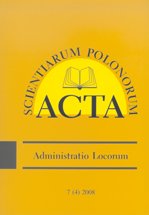Ramy instytucjonalne scalenia gruntów – porównanie w Polsce i w wybranych krajach Europy
Institutional framework of land consolidation – comparative analysis of Poland and selected European countries
Author(s): Małgorzata Dudzińska, Katarzyna Kocur-BeraSubject(s): Politics, Geography, Regional studies, Law on Economics
Published by: Wydawnictwo Uniwersytetu Warmińsko-Mazurskiego w Olsztynie
Keywords: land consolidation;plotting;rural areas;
Summary/Abstract: Land consolidation is currently perceived in a broader sense as an element of land development, introduced with the purpose of: creating more favourable conditions for management, improving efficiency, reducing production costs, creating appropriate infrastructure, improving the agrarian structure. The aim of the study is to present the institutional framework for the procedure of land consolidation in selected European countries. The document includes an analysis concerning this procedure on the basis of principles applicable in three countries: Poland, Lithuania and Norway. Poland and Lithuania have been selected as states from the Eastern Bloc in which agricultural reforms have been carried out. From a macro-economic point of view, the reform was an unfavourable phenomenon. Land allotment affected commercial farms of large and medium areas which carried out production for the market, which were replaced by small farms operating mainly to satisfy the needs of their owners and were able to sell only a small surplus of their products. Norway is a country with unfavourable farming conditions caused by its geographical location, climate and land form. The study applies the method of logical and descriptive analysis, based on Polish and international literature of the subject. The subject of the analysis mainly included guidelines and regulations concerning land consolidation in Poland, Lithuania and Norway.
Journal: Acta Scientiarum Polonorum Administratio Locorum
- Issue Year: 12/2013
- Issue No: 2
- Page Range: 29-39
- Page Count: 11
- Language: Polish

